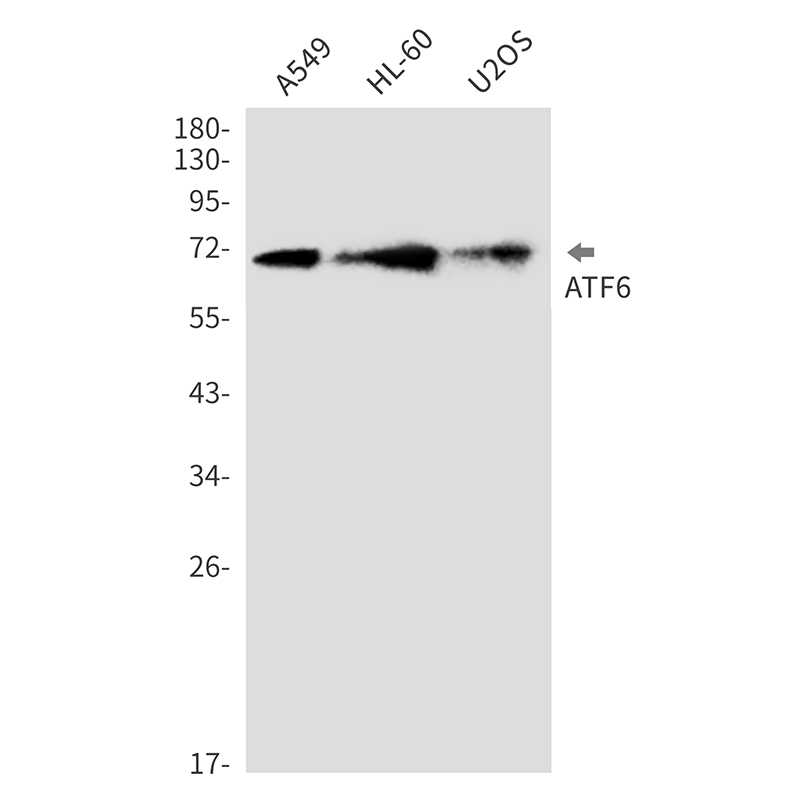

| WB | 1/500-1/1000 | Human,Mouse,Rat |
| IF | 1/20 | Human,Mouse,Rat |
| IHC | 1/50-1/100 | Human,Mouse,Rat |
| ICC | 技术咨询 | Human,Mouse,Rat |
| FCM | 咨询技术 | Human,Mouse,Rat |
| Elisa | 咨询技术 | Human,Mouse,Rat |
| Aliases | activating transcription factor 6; ATF6A |
| Entrez GeneID | 22926 |
| WB Predicted band size | Calculated MW: 75 kDa; Observed MW: 90-100 kDa |
| Host/Isotype | Rabbit IgG |
| Antibody Type | Primary antibody |
| Storage | Store at 4°C short term. Aliquot and store at -20°C long term. Avoid freeze/thaw cycles. |
| Species Reactivity | Human |
| Immunogen | Recombinant protein of human ATF6 |
| Formulation | Purified antibody in TBS with 0.05% sodium azide,0.05%BSA and 50% glycerol. |
+ +
以下是3条关于ATF6抗体的模拟参考文献示例(注:内容为虚构,仅用于演示格式):
1. **文献名称**:*ATF6-mediated endoplasmic reticulum stress signaling in hepatocellular carcinoma*
**作者**:Zhang Y, et al.
**摘要**:研究揭示了ATF6在肝癌细胞中对内质网应激的调控作用,通过Western blot和免疫组化(使用ATF6抗体)证实其高表达与患者预后不良相关,并发现其激活促进肿瘤细胞存活。
2. **文献名称**:*Role of ATF6α in neuronal ER stress response under oxidative stress*
**作者**:Chen L, et al.
**摘要**:利用ATF6特异性抗体检测神经元中ATF6α的核转位,证明其在氧化应激下通过调控分子伴侣GRP78表达减轻内质网损伤,为神经退行性疾病治疗提供新靶点。
3. **文献名称**:*ATF6 antibody-based screening identifies novel regulators of the UPR pathway*
**作者**:Kimura H, et al.
**摘要**:开发了一种高特异性ATF6单克隆抗体,结合CRISPR筛选技术,系统性鉴定出多个调控未折叠蛋白反应(UPR)的新型因子,为代谢疾病研究提供工具和机制见解。
(注:如需真实文献,建议通过PubMed或Google Scholar以“ATF6 antibody”、“ATF6 signaling”等关键词检索近年论文。)
The ATF6 (Activating Transcription Factor 6) antibody is a crucial tool for studying the unfolded protein response (UPR), a cellular stress mechanism triggered by endoplasmic reticulum (ER) dysfunction. ATF6. a type II transmembrane protein, acts as a sensor of ER stress. Under normal conditions, it remains inactive in the ER membrane. Accumulation of misfolded proteins prompts its translocation to the Golgi apparatus, where it undergoes proteolytic cleavage to release its cytosolic transcription factor domain. This active fragment migrates to the nucleus, upregulating UPR-related genes (e.g., chaperones, ER-associated degradation components) to restore proteostasis.
ATF6 antibodies detect either the full-length (inactive) or cleaved (active) forms, enabling researchers to assess ER stress status in diseases like neurodegeneration, diabetes, and cancer. They are widely used in techniques such as Western blotting, immunofluorescence, and immunohistochemistry. Specificity varies depending on the antibody's target epitope (e.g., N-terminal for full-length ATF6. C-terminal for cleaved forms). Validation using knockout cells or siRNA is critical, as cross-reactivity with other UPR pathways (e.g., IRE1. PERK) may occur. Commercial antibodies often cite applications in both human and murine models, supporting translational research. Understanding ATF6 dynamics through these antibodies provides insights into cellular stress adaptation mechanisms and therapeutic targeting of ER stress-related pathologies.
×